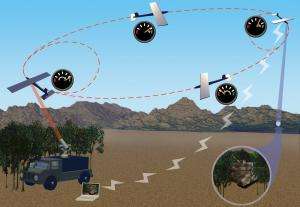September 9, 2010 report
Lasers keep mini helicopter hovering for hours

(PhysOrg.com) -- Seattle research and development company LaserMotive has succeeded in keeping a model helicopter hovering for six hours, powered only by the energy of a laser.
Conventional unmanned aerial vehicles (UAVs) are limited in their flying time because of the fuel or batteries they carry. Operation times can be extended if solar power is used in conjunction with batteries, as in Qinetiq’s ultralight Zephyr, which has been able to fly for 82 hours. Solar Impulse, a Swiss company, has also demonstrated solar powered piloted craft.
Unmanned vehicles used by the military tend to be stronger and heavier than ultralights, and it is difficult to power them with solar power because of their greater energy requirements, and this is where LaserMotive hopes to provide a solution.
The laser-powered model helicopter, which weighed only 22 grams, was demonstrated at Denver, Colorado last week at the AUVSI Unmanned Systems Conference. The tethered, radio-controlled model helicopter was powered by an array of semiconductor-diode near-infrared lasers, which produced laser beams that were then focused down to a single beam seven centimeters in diameter.
The beam, which will not damage eyes, tracked the helicopter automatically and illuminated the helicopter’s photovoltaic (PV) cells, which were optimized for the laser’s wavelength. The PV cells then converted around 50 percent of the laser power to electricity, providing just a few watts, but enough to keep the helicopter rotors spinning.
Tom Nugent, president, CEO and co-founder of LaserMotive, said he believed the six hour limit was set by the quality of the motor that drives the helicopter rotors, since it was only a small brush motor not designed to run continuously for that long. The tiny model flies under laser power until the motor burns out, he said.
Nugent also said he expected the system could be scaled to “anything anybody is interested in.” An unmanned vehicle could fly missions and return to recharge over the laser, or could hover over a laser base for lengthy periods.
LaserMotive demonstrated the use of lasers to power robots wirelessly last year, when it won the $900,000 Power Beaming Challenge sponsored by NASA for using a laser to power a robot climbing a 900-meter-long cable suspended from a full-scale helicopter.
The power beaming prize winnings could enable the company to help in powering space elevators to lift objects into orbit in the future, but such elevators are still at the concept stage. Other possible applications include delivering emergency power in disaster situations and to forward military bases or remote rural communities.
UAVs are among the fastest growing sectors in the aerospace industry and in defense, and the global market is expected to grow from the current $4.9 billion to $11.5 billion within ten years, according to industry analysts the Teal Group.
More information: LaserMotive - lasermotive.com/
© 2010 PhysOrg.com



















